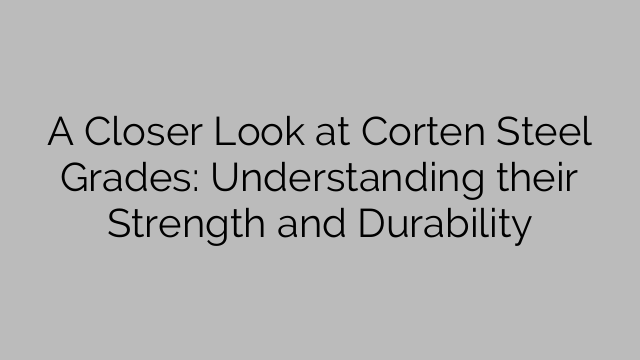Corten steel, also known as weathering steel, has been gaining popularity in architectural and outdoor applications due to its unique characteristics and aesthetic appeal. This type of steel has gained recognition for its ability to develop an attractive rust-like appearance, while also possessing high strength and durability.
Understanding the different grades of corten steel is essential for architects, designers, and engineers to decide which grade is most suitable for their specific project requirements. Each grade offers distinct properties and applications, allowing for versatile usage in various environments.
Corten steel is primarily composed of iron and a small amount of copper, chromium, nickel, and other alloying elements. These alloying elements enhance the steel’s corrosion resistance, toughness, and durability.
Grade A: Corten steel Grade A is the most commonly used type, offering high strength and excellent resistance to atmospheric corrosion. It is often used in structural applications, including building facades, bridges, and outdoor sculptures. Grade A corten steel develops a stable rust-like appearance over time, which acts as a protective barrier against further corrosion.
Grade B: Corten steel Grade B is similar to Grade A in terms of its composition and corrosion resistance. However, it possesses slightly higher tensile strength and may be more suitable for heavy-duty applications. Grade B corten steel is commonly used in construction equipment, railcars, and industrial containers.
Grade C: Corten steel Grade C is less common than Grades A and B but still offers excellent corrosion resistance. It has high tensile strength and is often used in structural applications where weight reduction is a priority. Grade C corten steel is commonly found in bridge components, transmission poles, and railcars.
Apart from the different grades, the thickness of corten steel also plays a crucial role in its strength and durability. Thicker corten steel plates provide enhanced strength and durability, making them suitable for high-stress applications.
One of the key advantages of corten steel is its ability to self-heal. When exposed to the atmosphere, a protective layer of rust forms on the surface. This layer acts as a barrier, slowing down the corrosion process and protecting the underlying steel. As a result, corten steel structures require minimal maintenance, making them highly cost-effective in the long run.
It is important to note that corten steel is not suitable for every application. Its unique appearance and weathering characteristics may not align with every design preference. It is crucial to consult with experts who have experience working with corten steel to determine whether it is suitable for a particular project.
In conclusion, corten steel grades offer strength, durability, and an appealing rust-like appearance, making them an attractive choice for architects and designers. Each grade has distinct properties that determine its suitability for different applications. By understanding the different grades, designers can make informed decisions to ensure the longevity and performance of their corten steel structures.
[ad_2]

